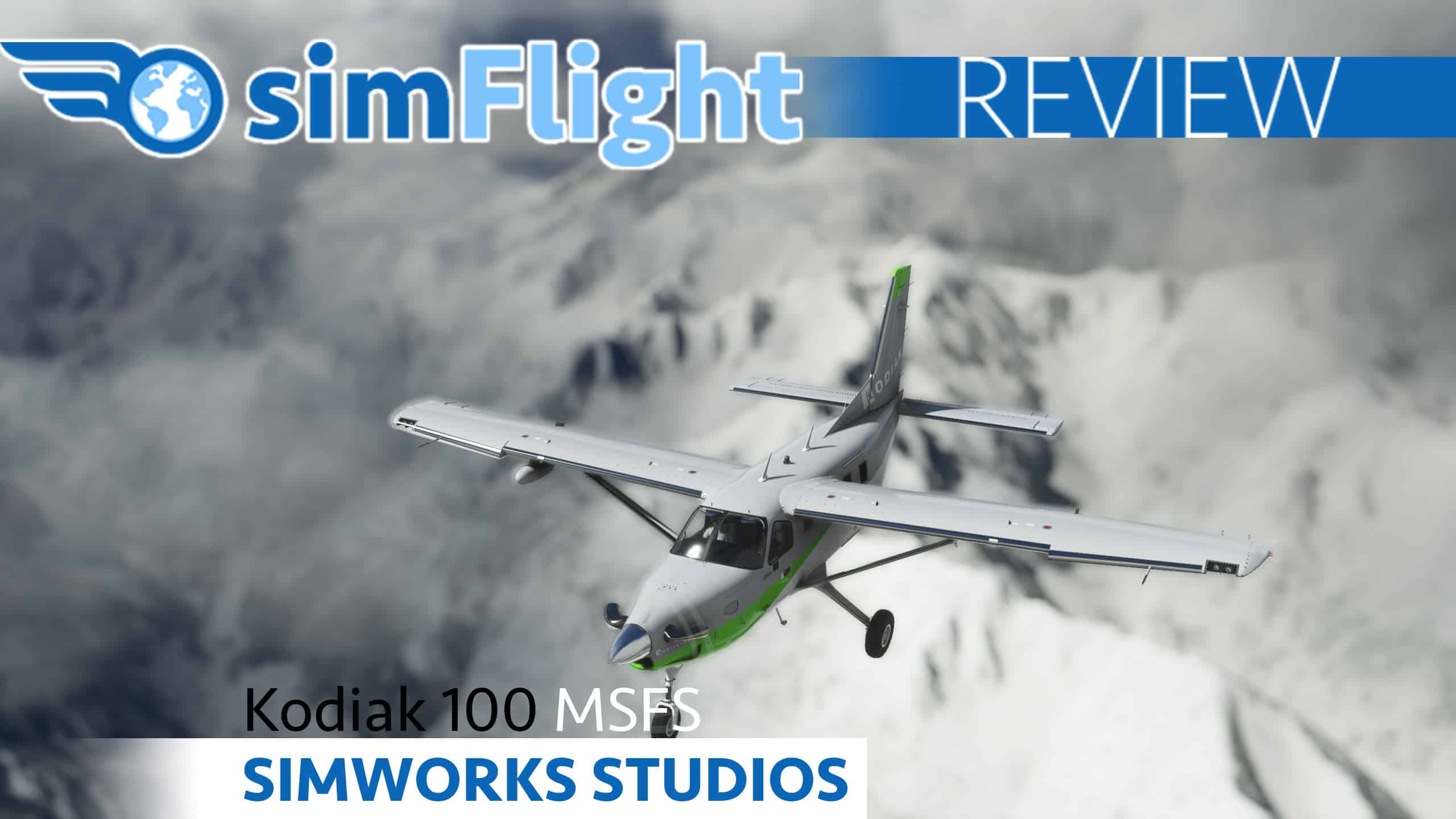
It is probably safe to assume many of you aviation geeks know about the Missionary Bush Pilot Youtube channel. Those unfamiliar with it may want to pay a visit right now, allowing their jaws to drop by the incredible content, thrilling and spectacular, then come back to read the rest of this article. Unpenetrated wilderness. Unpredictable weather. Unforgiving terrain. And the invincible Kodiak 100, determined to conquer them, against all odds.
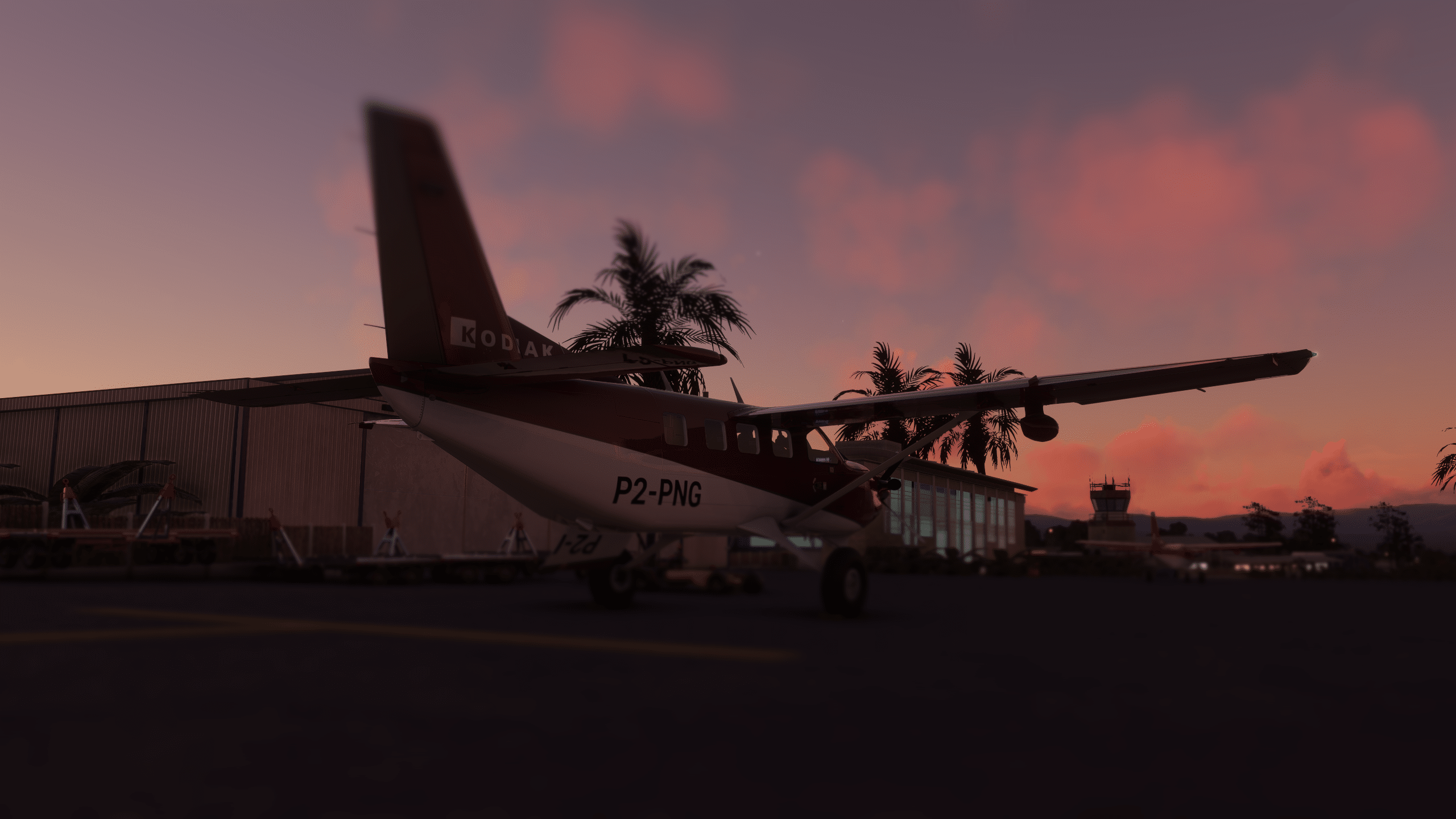
Apart from the guaranteed awe, who would not want to take this brave little turboprop for a spin, daring the unforgiving bush strips of Papua New Guinea? The good news is that everything an adventurous armchair pilot needs to experience the adrenaline rush of landing at some of the most challenging airstrips in Microsoft Flight Simulator is now readily available, including the aforementioned aircraft, thanks to SimWorks Studios.
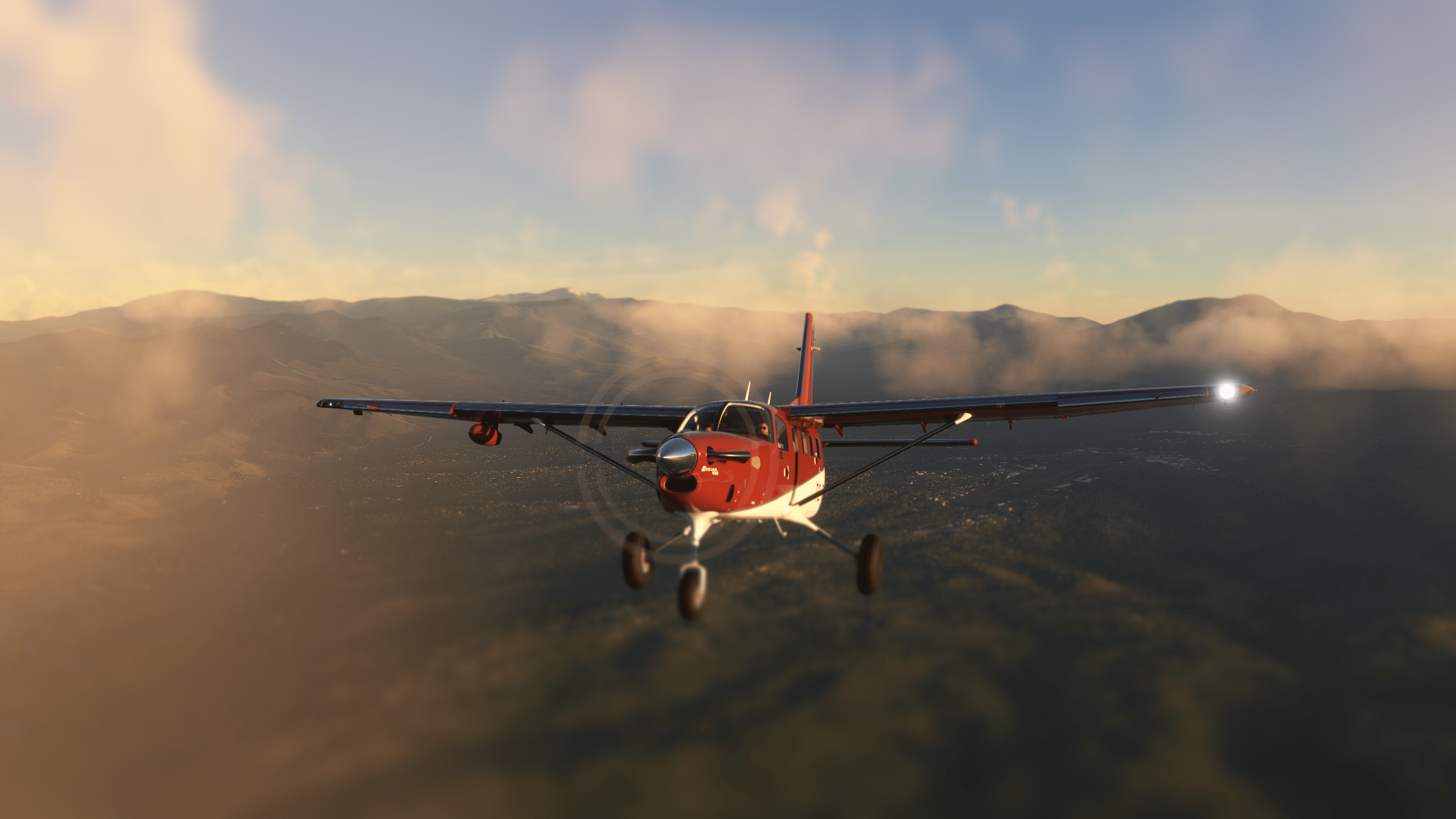
The Kodiak was designed and built by Quest Aircraft and made its maiden flight in 2004. It is a high-wing, unpressurized single-engine utility aircraft with STOL capabilities, perfectly suitable to operate out of unprepared strips, making it an ideal bush plane. In 2019, the Idaho-based company was purchased by the French manufacturer Daher. It can carry up to nine passengers, with a range of over 2000 kilometers (1100 nautical miles). To date, over 300 have been delivered.
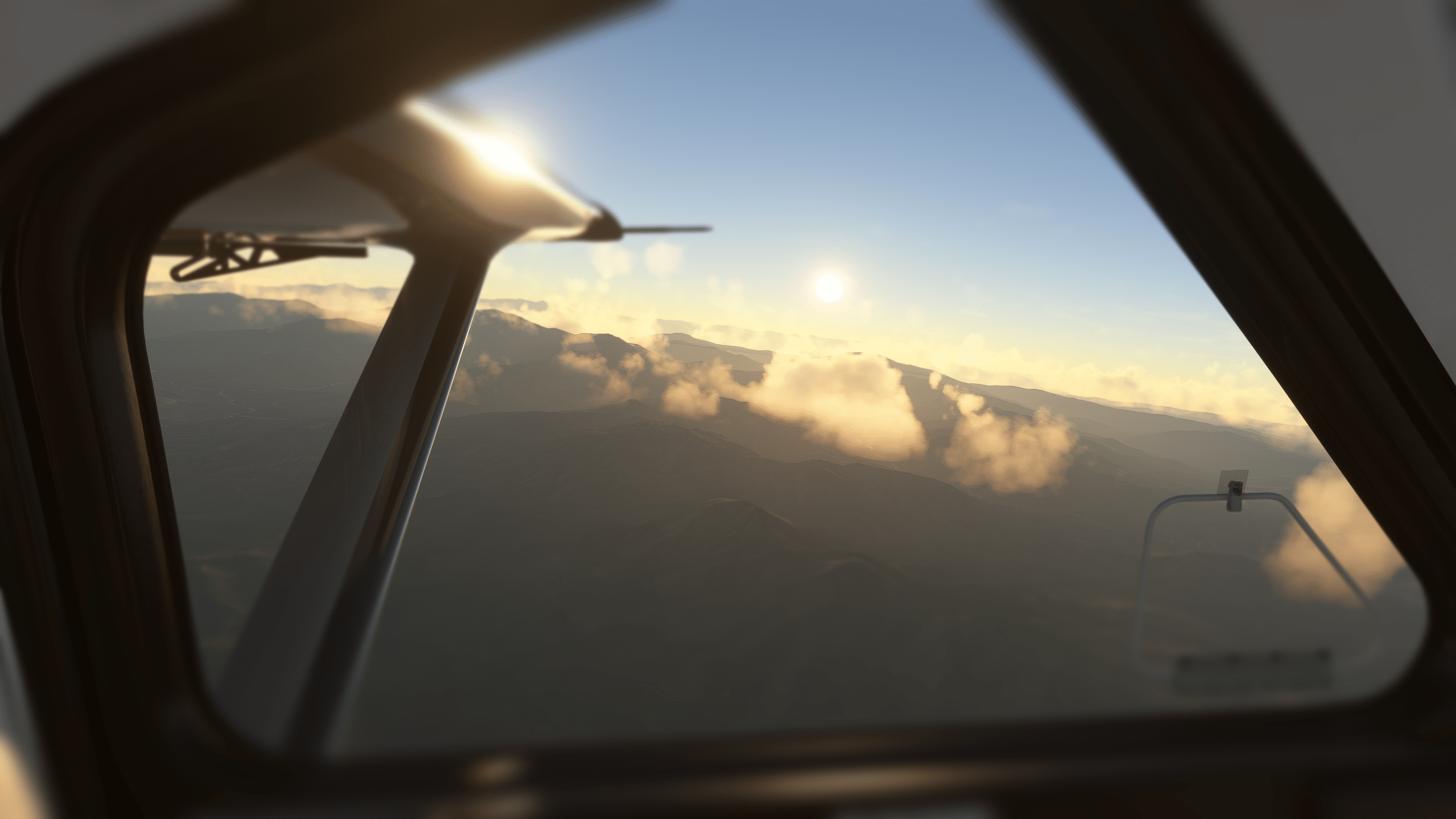
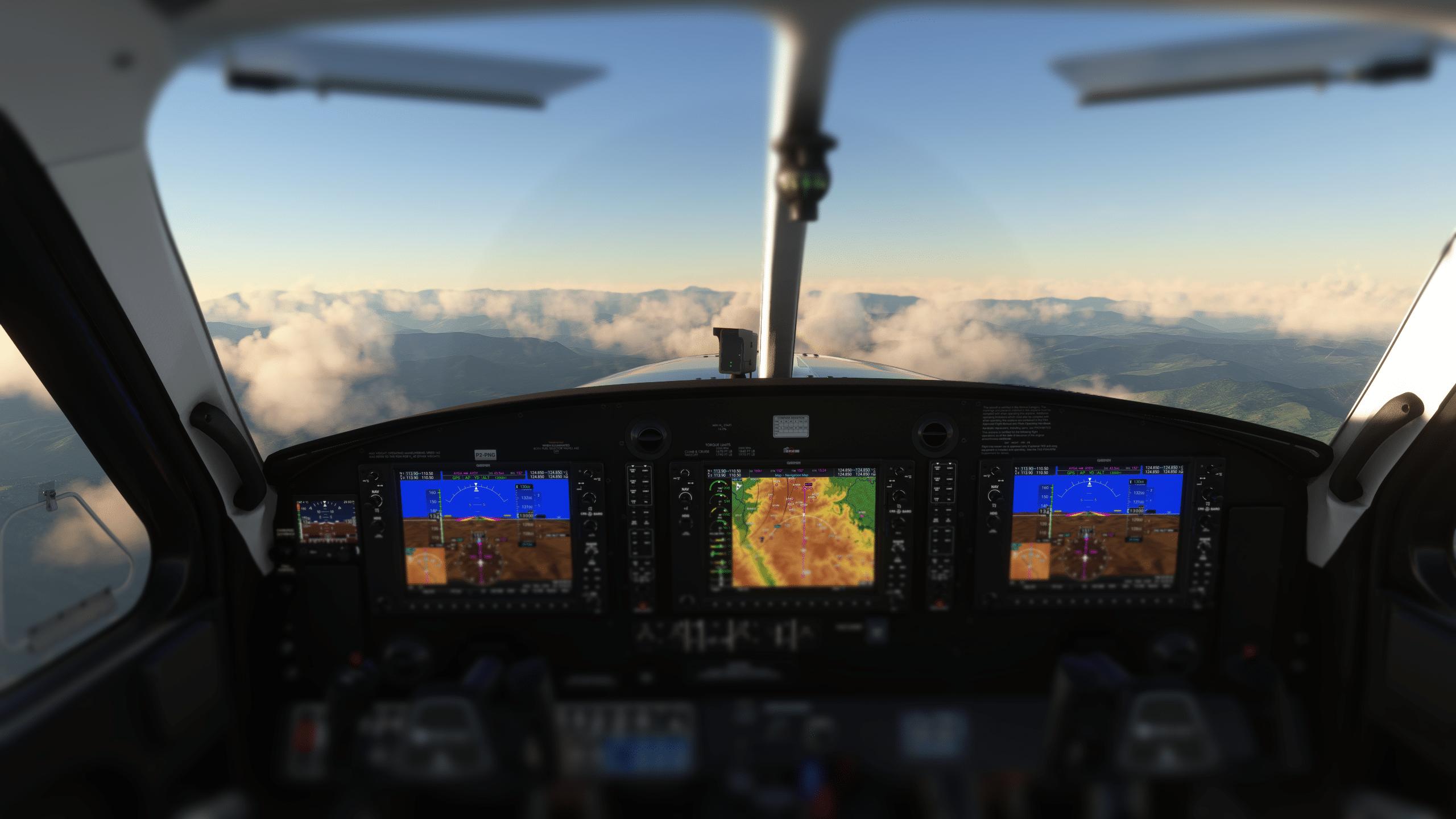
But let us now focus our attention on our beloved virtual universe. Before SimWorks Studios released the model for Microsoft Flight Simulator, most of us had to make certain compromises, deploying the Asobo Cessna 208 Caravan for the purpose. While it did the job, the user experience was not the same until the day dawned upon us and our shiny new Kodiak 100 finally rolled out from the hangar.
Allow me to share with you my first impressions and experiences with this glorious aircraft. Unlike conventional reviews that systematically go through each part of the product, starting with the exterior, followed by scrutinizing the interior, the textures, the systems, nit-picking on a missing rivet, my approach is different. I prefer to ride the horse to get to know it and check out what it has to offer along the journey.
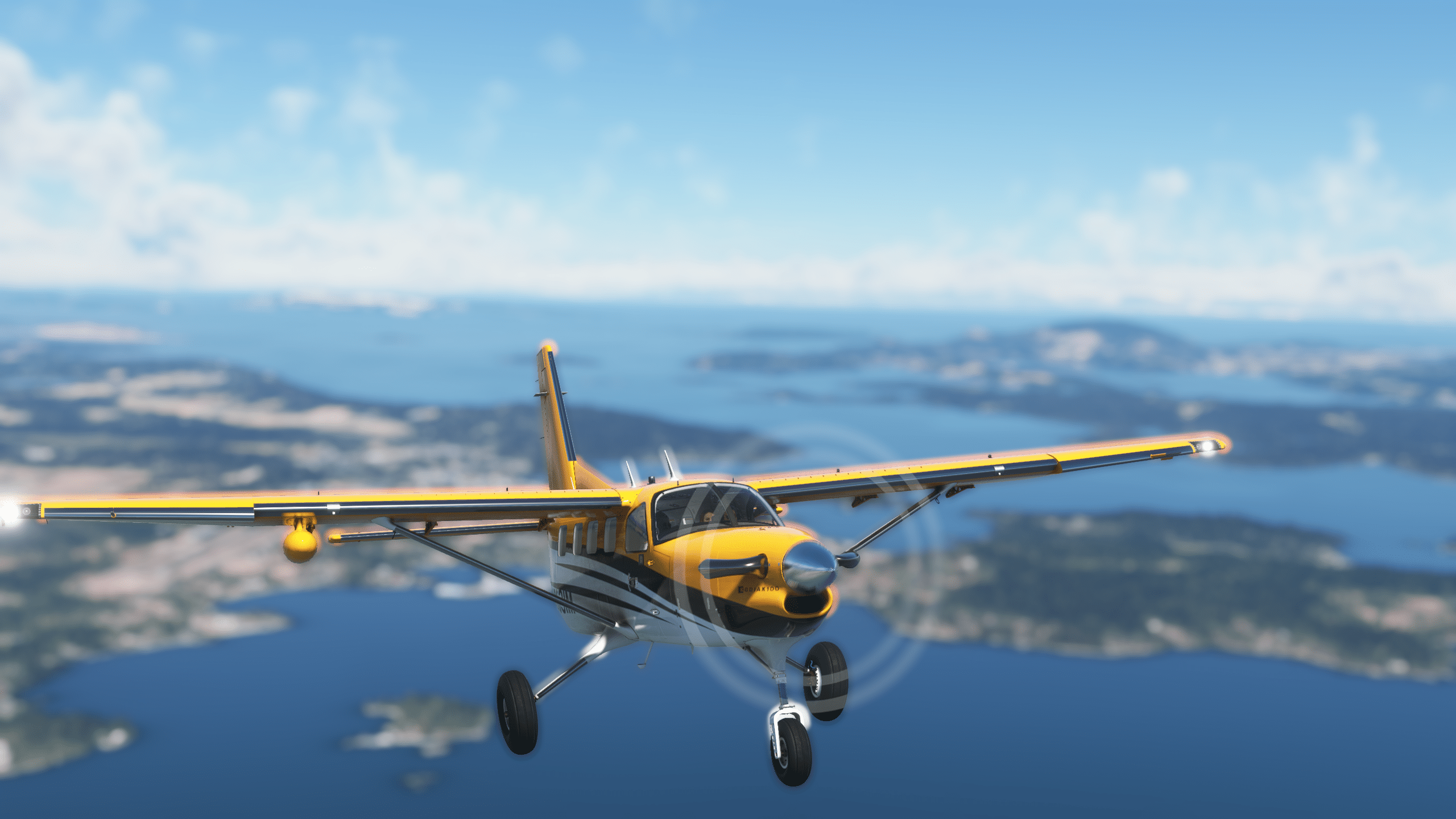
After purchase, it is recommended to embark on a quick detour to the Working Title Simulations website and grab their early access beta release of the Garmin G1000 NXi, replacing the stock G1000 suite. The Working Title NXi offers dozens – if not hundreds – of improvements over the default package, expanding the functionality of existing features; adding several new ones. I dare to say, it is an absolute must for all aspiring Kodiak captains. The wonderful thing is that this classy glass cockpit “upgrade” costs literally nothing.
It is also a good idea to download and install the free utility called Toolbar Pushback. Reversing out of tight general aviation “corners” can be tricky without beheading an otherwise immortal virtual ramp agent with the wing. Let us just conclude the tool significantly increases the immersion factor. Very easy to operate, it quickly grows on the pilot, becoming a must after trying it for the first time.
Our new Kodiak comes with as many as four different variants to choose from, allowing us to pick the one most suitable, depending on the task at hand. We can go with conventional or tundra tyres, and have the option to equip our airframe with a cargo pod. Besides, there are five different interiors available: summit, tundra, skydive, mixed, and cargo. And if it was not enough, the aircraft is shipped with as many as 40 different liveries.
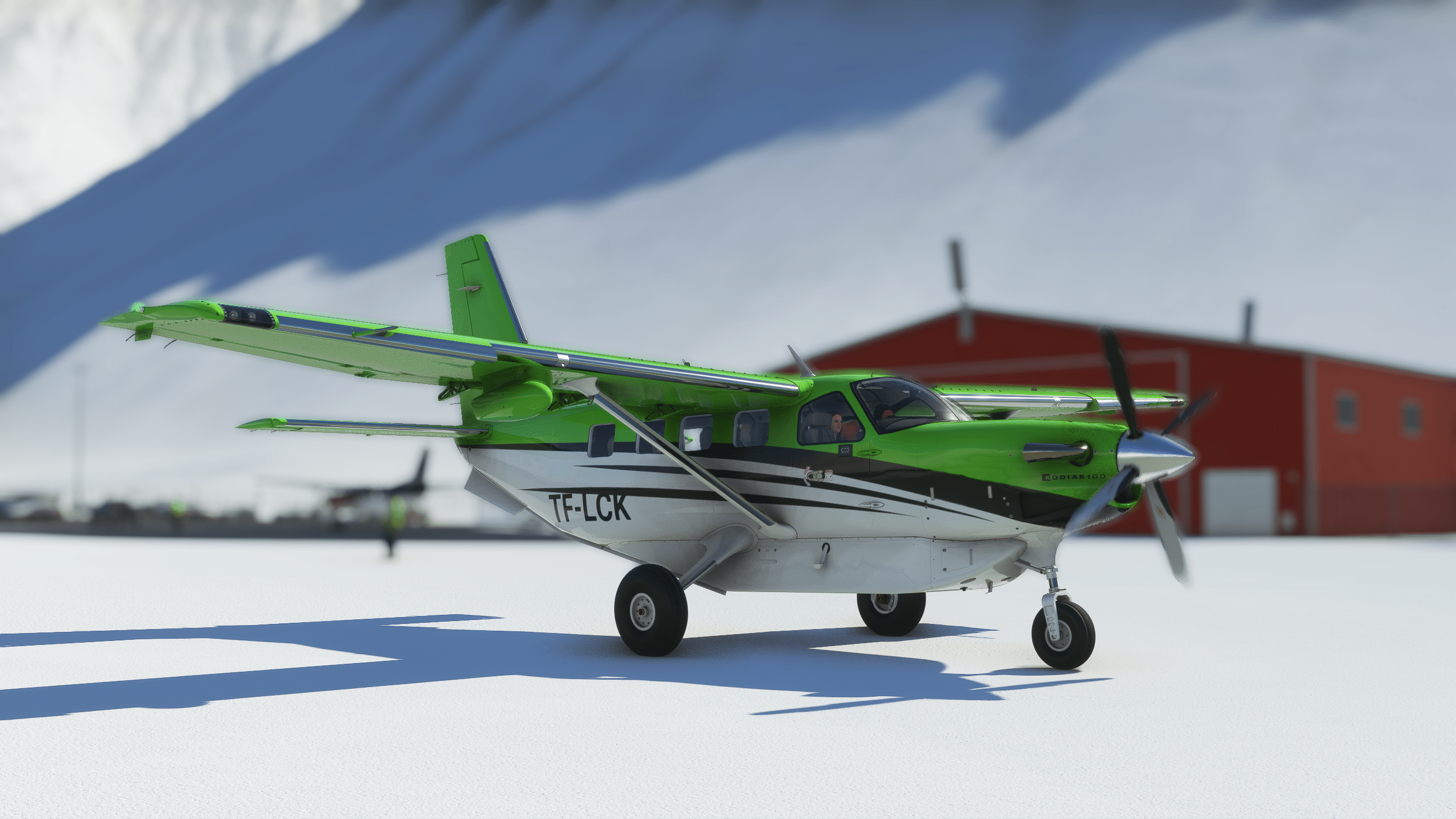
Summit is the executive arrangement with a sleek, elegant layout, comfy leather seats, and folding tables for those important business trips. Due to performance considerations, SimWorks Studios chose not to include passenger models with the Summit interior, leaving “them” to exist in our imagination.
Tundra offers a standard passenger layout with eight seats. When fully loaded, it is easy to end up with an out-of-limit center of gravity so it is recommended to exercise caution when loading the aircraft. This holds true for every variant and interior but appears to be most prominent in Tundra. Also, it is crucial to keep the CG between 14-40% MAC.
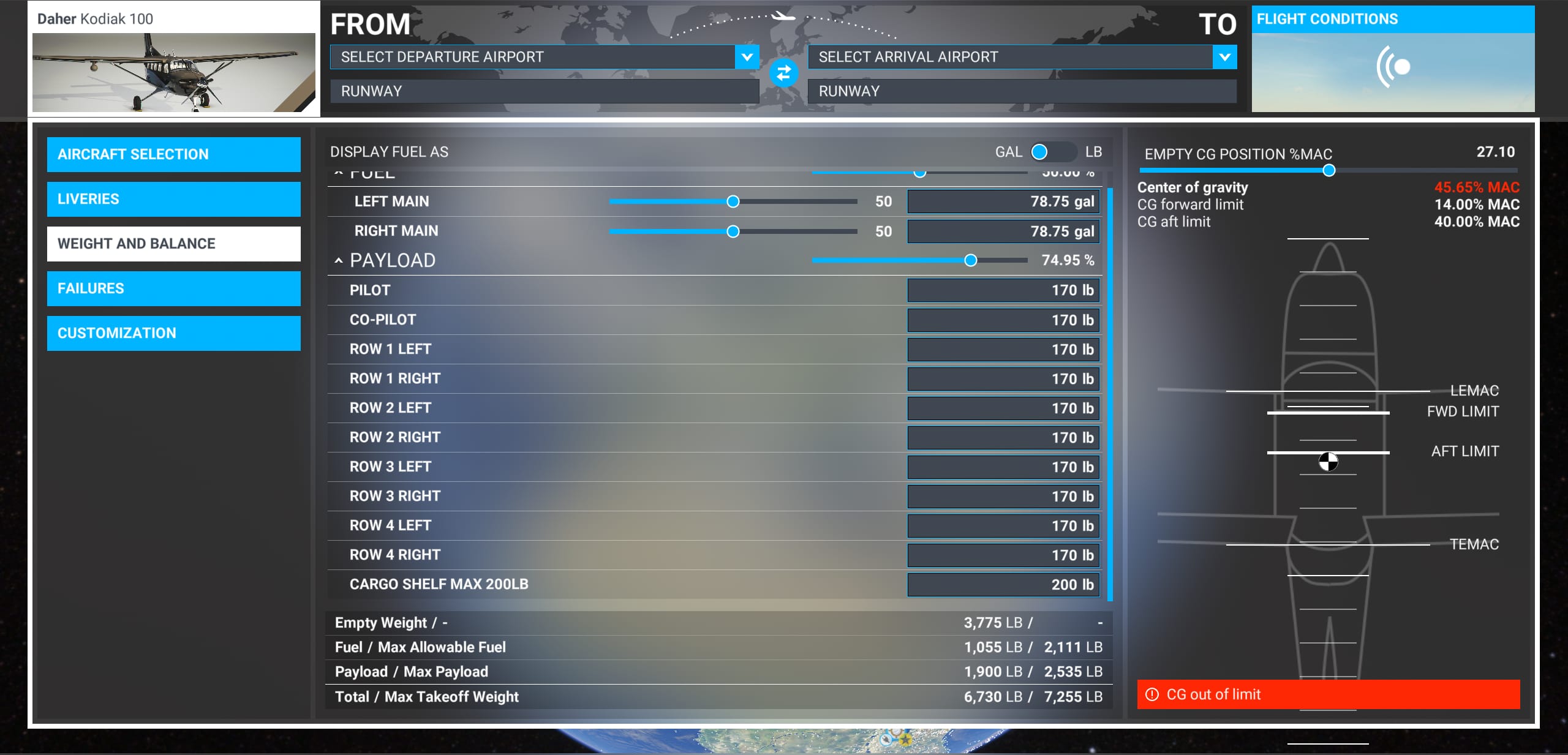
For each passenger seat, if the weight added is at least 110 Lbs, a static passenger figure is magically made visible from both the flight deck as well as in external views. While low-poly, they – three of them being female, three of them male – serve the purpose well, without being distracting or in the way. Not as pretty as some of the available virtual copilots but believable enough to be passengers. Still, an option to turn them off completely would come in handy as some might not like them as much as I do.

Cargo has no passenger seats at all, it is a configuration for dedicated freight hops. Pax are replaced by boxes, again, depending on the weight added via the default weight-and-balance utility.


Mixed offers a fair balance between Tundra and Cargo: there are four passenger seats and the rest of the cabin is available for freight. It is a little bit concerning though, that in case of an emergency, passengers are somewhat stuck between the “flight deck” and the “cargo hold” without easy access to an exit. We also get our lovely static passenger and parcel models both internally and externally.
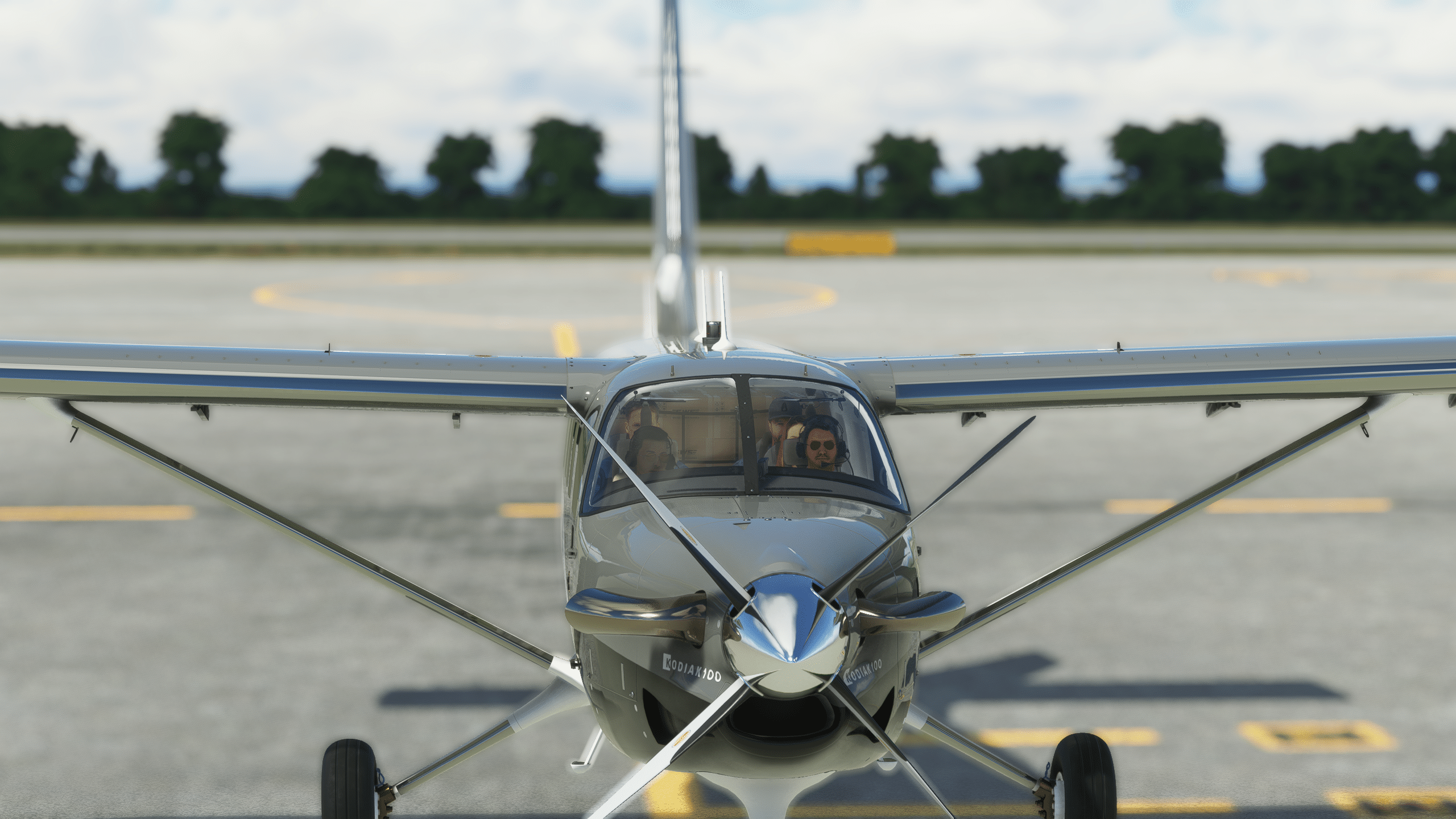
Skydive is exactly what the name says, with a working roll-up door for daredevil jumpers. Be warned, if you take off with a door – or window – open, the aircraft will suffer damage due to stress unless you have the relevant option turned off in your settings. Similar to Summit, this interior layout does not feature static passengers due to performance reasons.
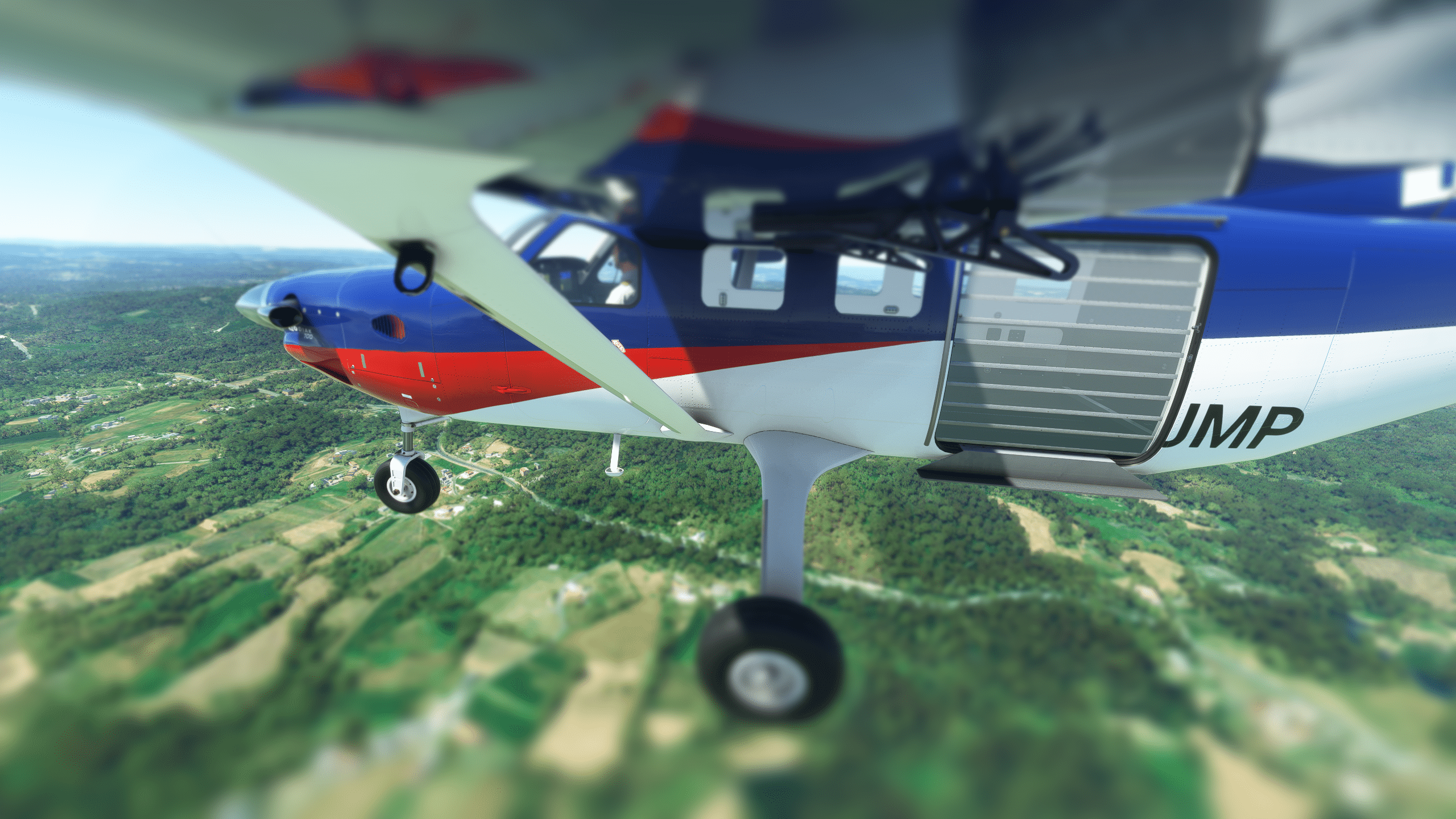
Operating the SimWorks Studios Kodiak is fairly straightforward. The cockpit is dominated by the huge Garmin displays, presenting the pilot with all the information needed to safely conduct the flight. The screens come to life once the battery is switched on, and following a quick self-test, they are ready to rumble.
It is a good idea to set up the Environmental Control System next, which is situated on the copilot’s side of the pedestal panel. Note that the Auxiliary Bus switch must be on for this system to operate. Without it on, chances are the panel will be left unnoticed. On the overhead, both left and right fuel selectors need to be on, and the “firewall” fuel shutoff lever (pedestal panel) should be pushed in before starting the engine. Overall, the aircraft can be prepared for flight within less than two minutes from a cold-and-dark state.
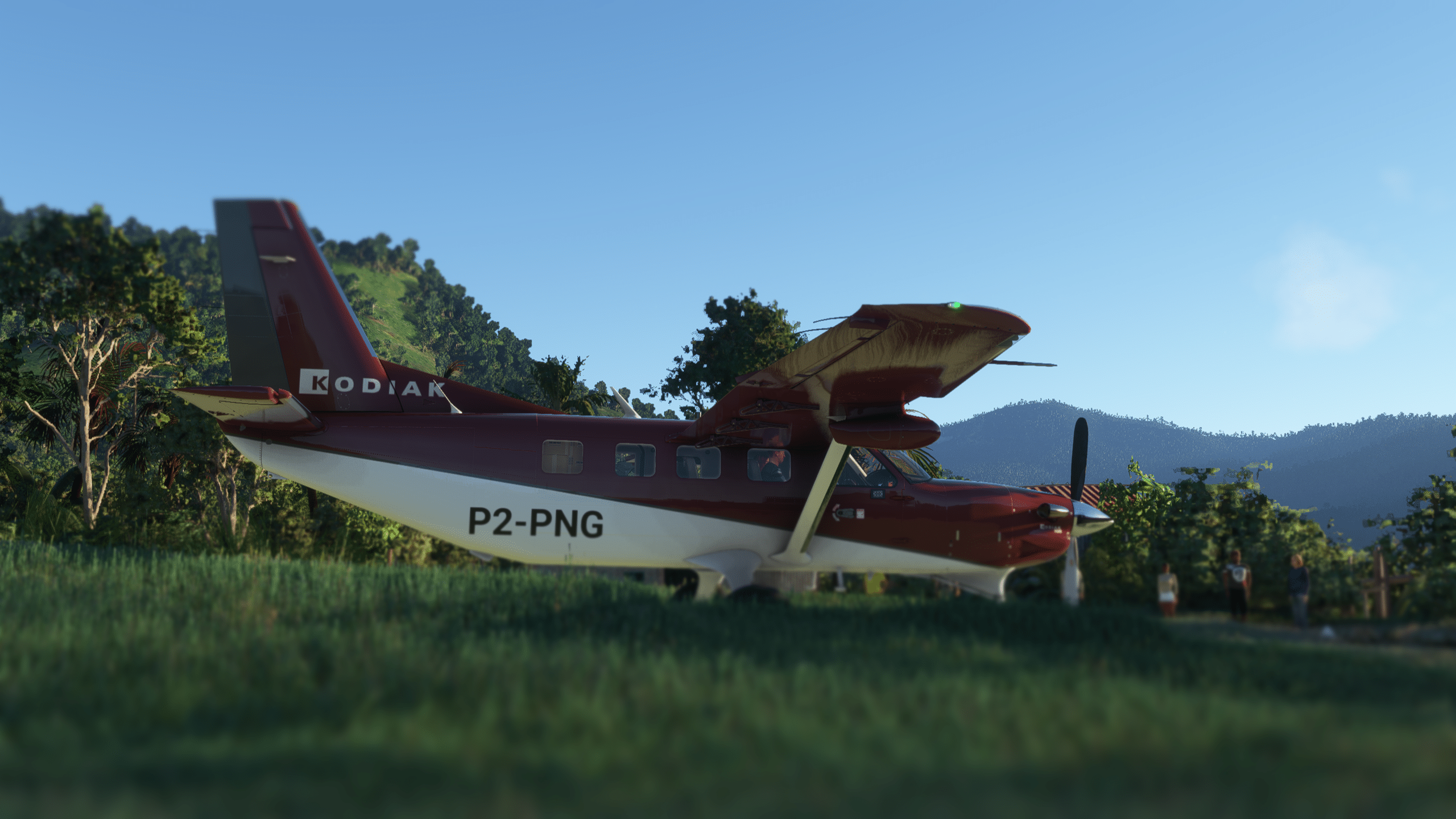
Depending on the hardware used, it might be a good idea to lower pedal sensitivity in the control options. The Kodiak requires a lot of right rudder during the takeoff roll, be prepared. Rotation speed is around 60 knots and the aircraft climbs nicely around 95-101 knots IAS. Refer to the supplied performance charts for the maximum takeoff torque and keep an eye on your engine instruments at all times.
It is a pleasure to hand-fly the SimWorks Studios Kodiak 100. It is responsive yet smooth, truly a pilot’s airplane. While the autopilot does the job well when it comes to capturing and maintaining altitude, it often overshoots headings (VOR, localizer), requiring it to correct itself. Nothing to complain about and this might well be the behavior of the real aircraft, too.
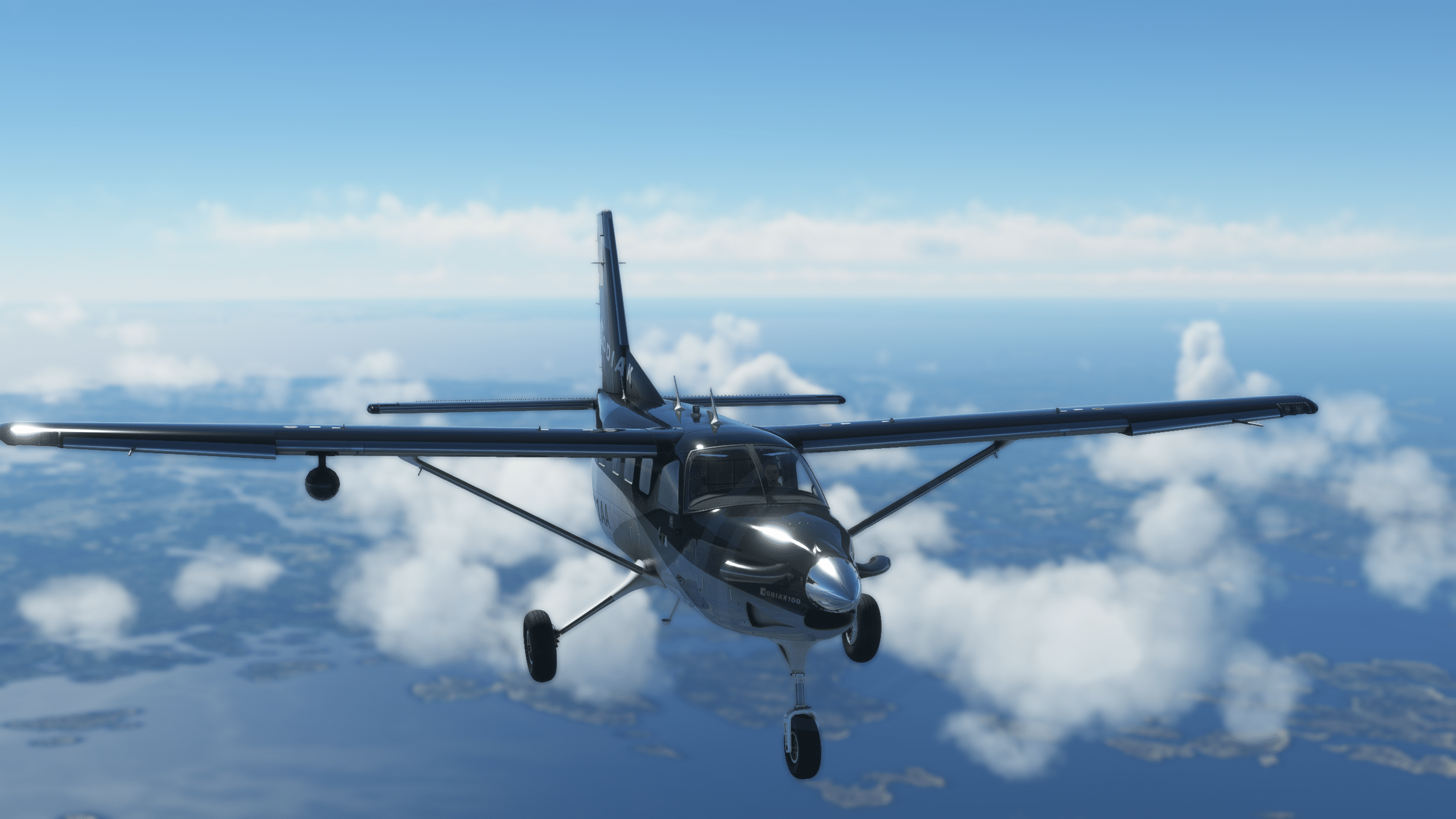
Difficult approaches are a must if you want to call yourself a hardcore Kodiak pilot. Try Papua New Guinea’s Sindeni “airport” for a healthy challenge. Airports such as London City or Toronto’s Billy Bishop Airport will be a piece of cake after training in the Papuan mountains. There is no shame in controlled flight into terrain on your first few attempts, those bush strips “carved” into mountains’ edges are trialing even for the most seasoned pilot. Truly, this is where the Kodiak shines. Slow down, go flaps 35, you can land where no one else can, not with the payload you can carry at least. You get there fast and in style. No airport is beyond reach for the aircraft, the only limitation can be the pilot flying.
My favorite flight took me from St. Gallen’s Altenrhein (LSZR) airport to Lugano (LSZA) over the Swiss Alps. Not quite a bush trip but entertaining enough, requiring a high-performance climb up high to clear the peaks, and a proper steep approach to complete the journey. There is simply no better aircraft than the Kodiak to conduct this flight. After taking off from RWY 28 at Altenrhein, we followed the SITOR 2V SID, passing SITOR above 5000 feet, climbing to our cruising altitude of FL170 for this flight. At SITOR, we turned left, direct to ODINA, which is also the first STAR waypoint. There is plenty of sightseeing opportunity before ODINA though, mountains, valleys, lakes, forests, and charming little towns deep below us. In the meantime, we effortlessly reached FL170+ in just over 10 minutes, at a vertical speed rate of 1300-1800 fpm, easily avoiding terrain. Depending on the load factor it may take slightly longer at other times but overall, the Kodiak climbs like a rocket, thanks to its beast PT6A-34 turboprop powerplant. With the top of descent fast approaching, we are already hard at work preparing for the arrival. The procedure required us to pass ODINA at FL150, and then, continue our descent to meet the next constraint of passing overhead the airfield at FL110. The G1000NXi handles the tasks without issues, making the Kodiak perfectly suitable for all-weather IFR operations. At CALDO, we flew the procedure turn to intercept the localizer and tackle the 6.65-degree descent angle approach into Lugano.
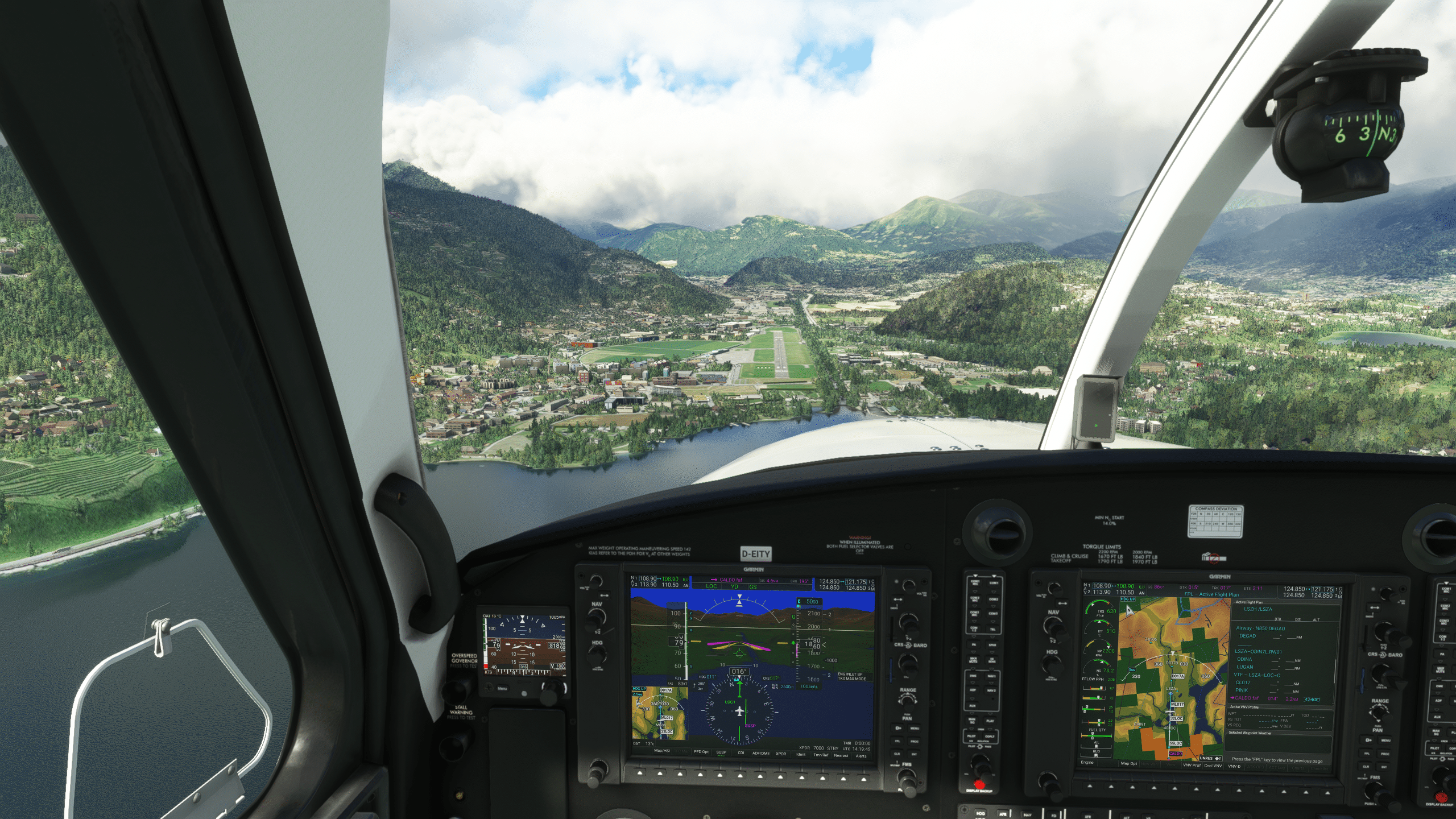
While conventional approaches can easily be flown matching the pace of jets, maintaining 130-140 knots IAS until 2-3 DME out, thus not upsetting some air traffic controllers, steep approaches like LSZA call for slowing down in a timely manner to keep both speed and altitude at bay. If done correctly, it is truly rewarding to touch down in Lugano in the Kodiak.

Operating the aircraft in icing conditions, the pilot has a number of “weapons” at the ready. First, the two pitot heaters. Whenever the outside air temperature plummets to 5-degrees Celsius or below, the system reminds us to turn them on. Then we have the surface/prop de-icing system, which requires the engine inlet bypass switch to be set from normal to bypass. Although the surface/prop de-icing knob has multiple stages (off, normal, hi, and max), all labeled, I was not able to select any of the intermediate positions, leaving me with off or max only. There is a dedicated switch to heat the windshield.
Flying during the hours of darkness used to be a hit or miss on other platforms, an area where many products eventually failed, although it was not necessarily the product’s fault, but more of a limitation of the host simulator.
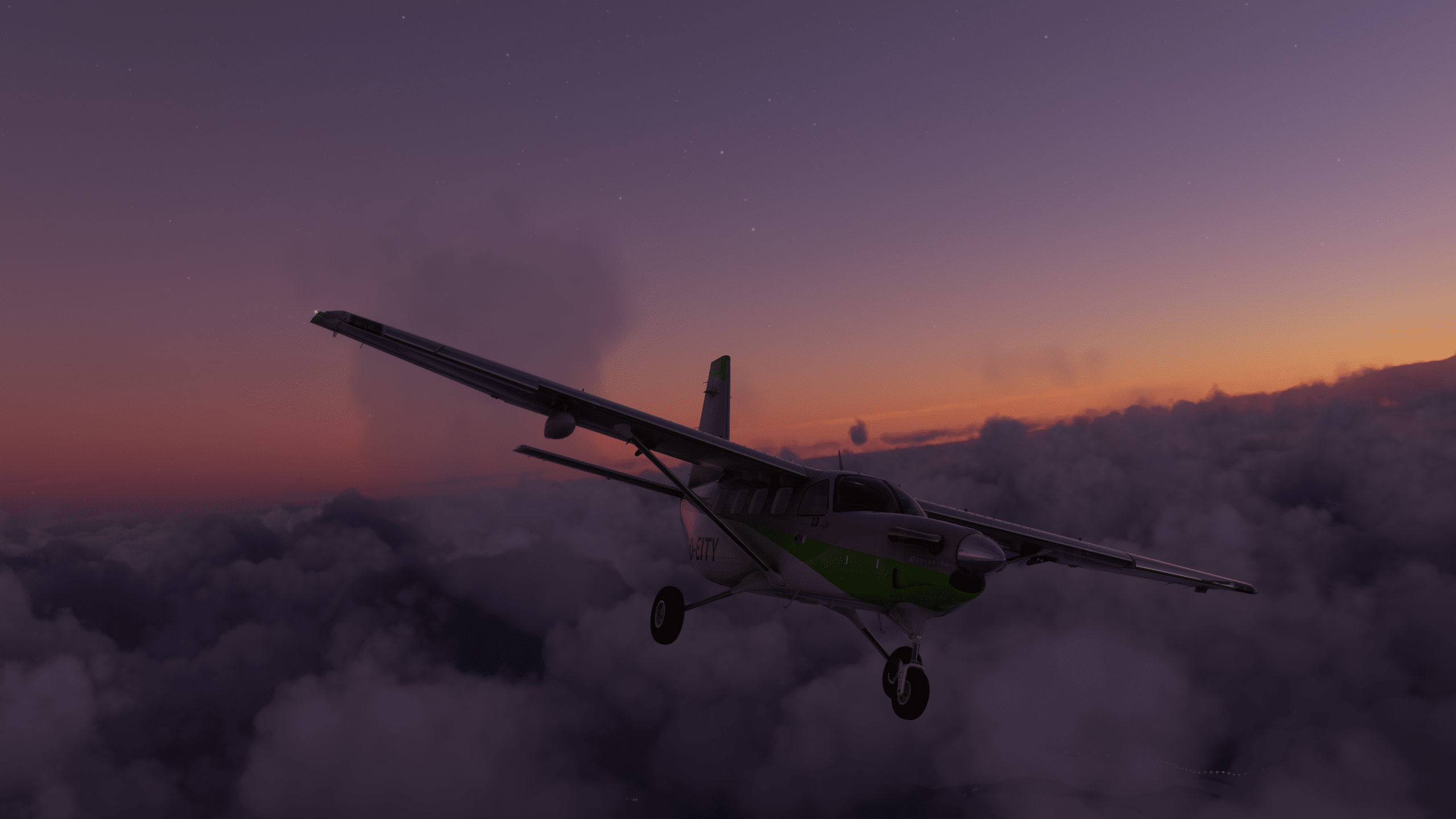
Not anymore, since Asobo and Microsoft did a very fine job when it comes to cockpit illumination and lighting, as a whole. Nevertheless, it is still up to the aircraft developers to take full advantage of what is available. The Kodiak has everything an armchair pilot would ever want for a cozy night flight. Some prefer a cockpit as dark as possible, dimming everything except the instruments. Some prefer a bit of illumination. It really comes down to preference, and the good news is that whatever lighting configuration appeals to you, the SimWorks Studios Kodiak allows you to manipulate those knobs in a multitude of ways so that you can achieve what suits you best.
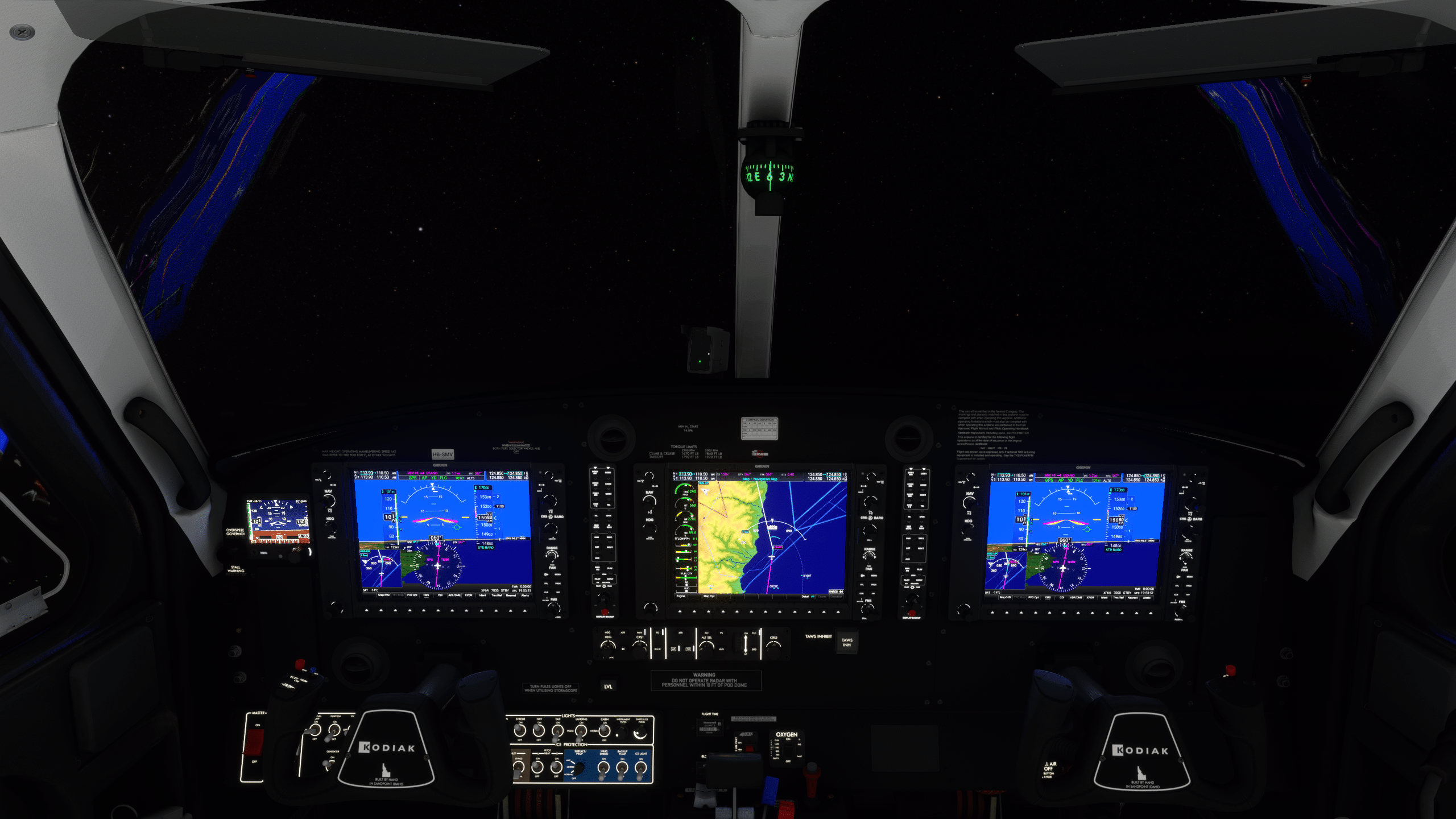
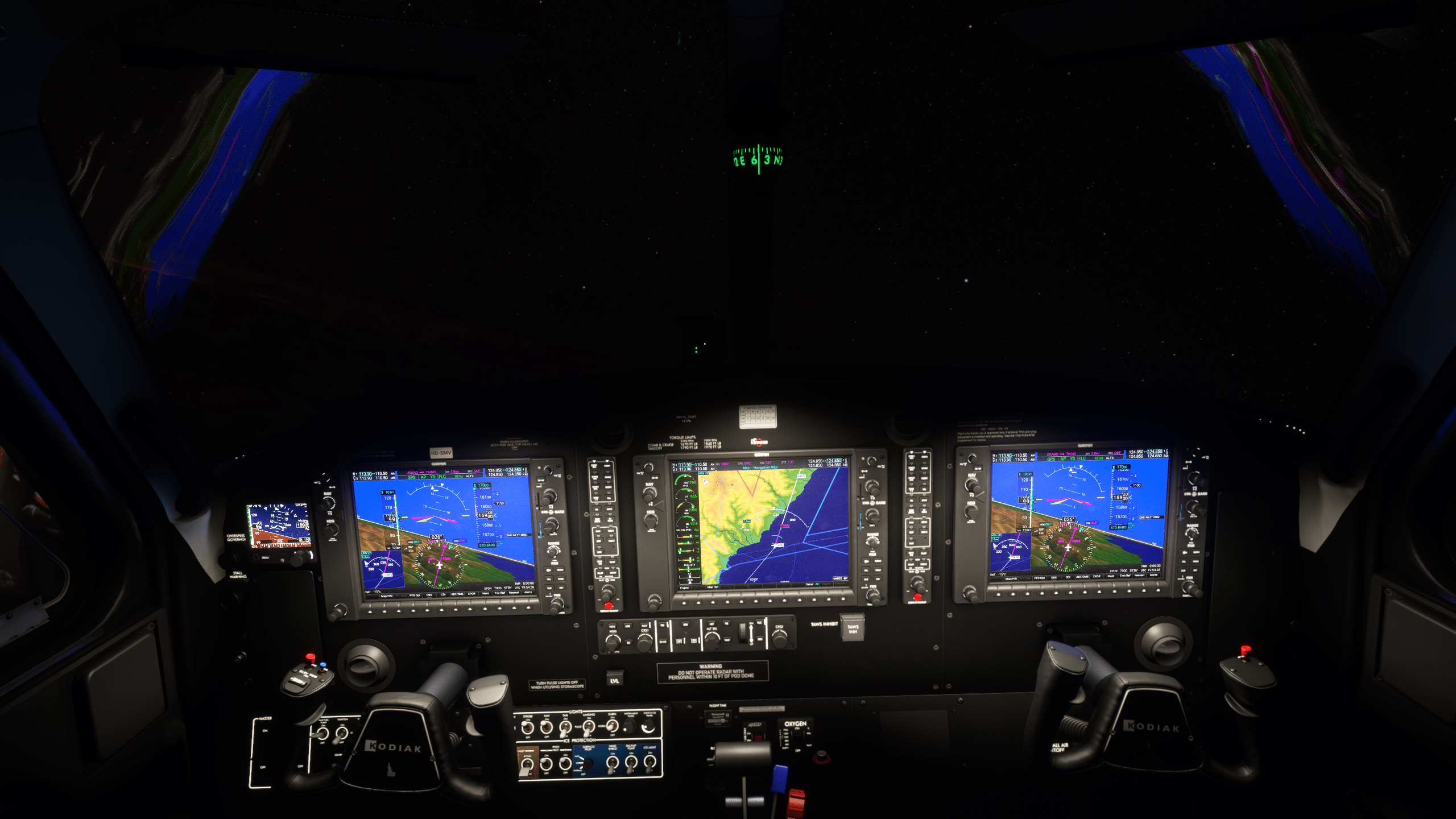
The developers went to great lengths to ensure every aspect of cockpit illumination is faithfully reproduced, making night flying in the Kodiak not only immersive but outright a pleasure. Interior lighting in the aircraft is controllable in several ways. First, there is a harsh and bright cabin light for those always-on-the-road businessmen; the prime reason why I tend not to fly the Summit interior at night. They always demand the lights to be on so that they can squeeze out yet more work even during a quick flight. Come on, dude! There is a master switch that turns them on or off (the cabin lights, not the businessmen, unfortunately). For takeoff and landing, regardless of how important a CEO sits in the cabin, these get dimmed. Period. Then we have a couple of knobs to adjust the instrument backlight and cockpit illumination, which can be nicely fine-tuned, as required by the time of day and available natural light. There is also a working jump light when the Skydive interior is selected.
SimWorks Studios did an extraordinary job with the number of options, details, and functionality that went into the product. It clearly shows the passion, tremendous dedication, and love the team has for their winged baby, resulting in what can safely be considered one of the best, most realistic, and visually appealing aircraft add-ons ever released for any flight simulator. Big words, maybe, but words of truth: in its category, the SimWorks Studios Kodiak is truly a king of its castle. It looks and feels real in every aspect.
But what makes it feel real? If I tell you that all doors can be opened and closed (not only closed but also locked) or that both sunshades work just like in the real aircraft, you will probably not raise an eyebrow. If I tell you, however, that even the Hobbs meters are functional, now that is something. The different variants are really different. Not only visually but they behave differently, too. The aircraft comes equipped with a custom ESI500 standby instrument, fully capable of VOR and GPS navigation. To assist the pilot, the SimWorks Studios Kodiak – just like its real-world brother – is also blessed with a so-called flap auto-trim system that automatically adjusts trim when the flaps are in operation, reducing the workload of the pilot during critical phases of the flight. And even all of these are merely a fraction of what SimWorks Studios put into this aircraft.
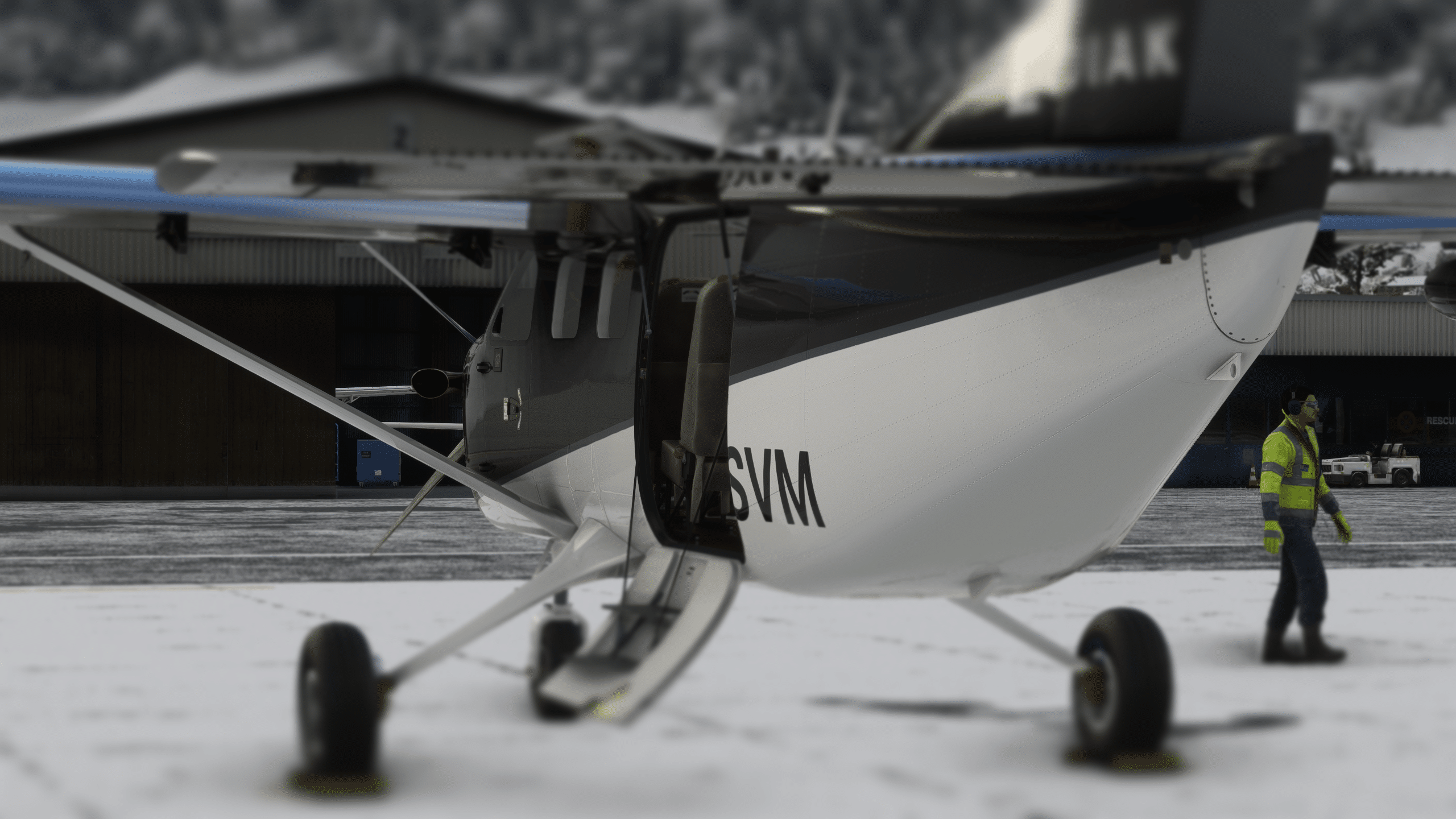
Anyone with an interest in general aviation, bush flying involving challenging approaches and rough strips, or even VIP flights from and to “conventional” runways without the added thrill factor, may want to consider the Kodiak. SimWorks Studios packed so much into this product that it takes a long time until every hidden gem is eventually revealed. Every flight, therefore, is a discovery flight, with a new “secret” being unveiled. I dare to call it a study-level simulation of the type, and while I am not familiar with the real Kodiak, the product is convincing enough to make me believe I am flying one.
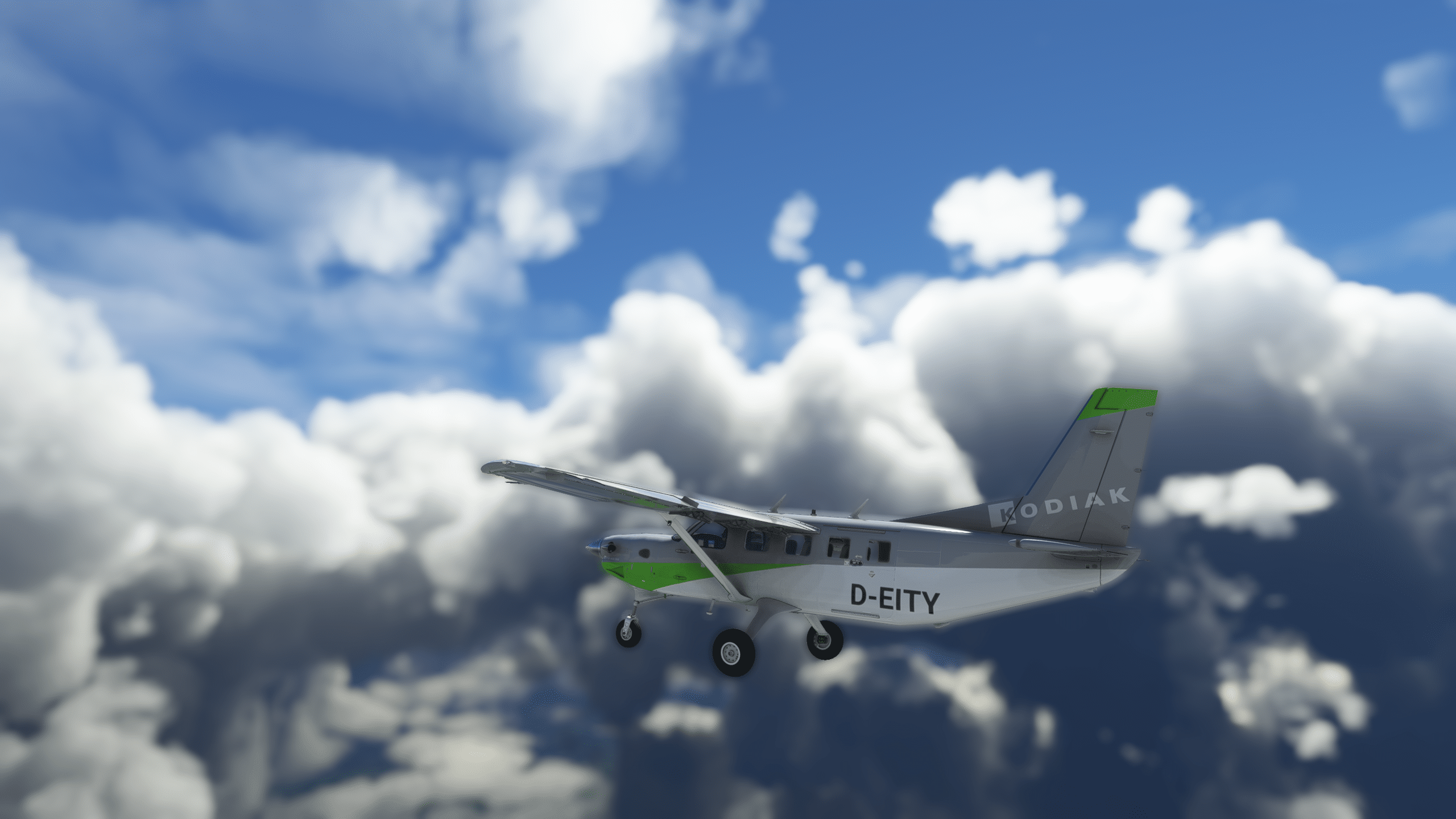
Without a shadow of a doubt, this release marks the pinnacle of a general aviation aircraft simulation. How lucky we are to have developers like SimWorks Studios who keep pushing the limits further and further. I am looking forward to whatever comes next from their factory.
| Pro | Con |
| – Stunning exterior & interior 3D model – Super crisp textures – In-depth systems – Rich and realistic sounds – Numerous variants and repaints – No noticeable impact on FPS | – Could not “get rid of” the low-poly passenger models – A “tablet” with weight and balance adjustments and refueling would be a nice addition – Lack of a lavatory (only joking!) |
| Purchase | Test System |
| Simmarket Developer: SimWorks Studios Price: EUR 34.99 | IntelCore i7 6700K CPU @ 4.50 GHz GeForce GTX 1070 with 8 Gb GDDR5 Windows 10×64, 16 Gb Corsair Vengeance LPX DDR4 Multiple SSDs |







